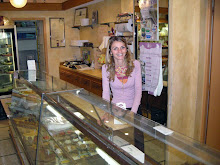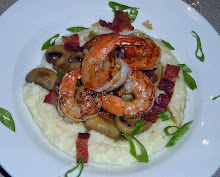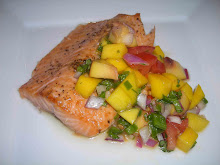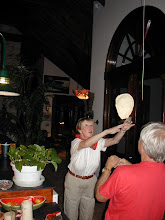Thursday, July 26, 2012
Salad with Cherries, Goat Cheese and Pistachios
I couldn’t help but buy a box of the pretty Rainier cherries from Washington State when I saw them in our market the other day. I knew I had to have that box of cherries, even though I had no particular recipe in mind at the time.
Normally when it comes to cherries, I like to make a clafoutis, a baked French dessert of cherries covered with a thick flan-like batter and served warm, dusted with a generous shake of powdered sugar. But it’s summertime and I’m really not interested in heating the oven to make a baked dessert. Also there’s something about a clafoutis that I associate with fall evenings and it’s only July.
As often the case, Cooking Light came to my rescue. As I flipped through a great article featuring twelve different cherry recipes, I chose the salad with cherries, goat cheese and pistachios.
I did learn something about advance prep and cherries. Thinking I was the smart one, I pitted the cherries about 45 minutes before I began to assemble the salad, which, by the way, only takes about 15 minutes total start to finish. Cherries are quite easy to pit if you have a cherry pitter. When I came into the kitchen to finish the recipe, much to my surprise the edges of the pitted cherries had darkened and frankly weren’t nearly as pretty as they were freshly pitted 45 minutes earlier. So a word to the wise – if you want pretty cherries, do not pit light colored cherries such as Rainier until the last minute.
Don’t let cherry season pass you by. This is a very easy recipe and looks quite impressive on the plate. To complete the meal, we served this alongside a grilled NY strip steak.
Salad with Cherries, Goat Cheese and Pistachios
Adapted slightly from Cooking Light
4 cups arugula
2 cups mix baby greens spinach
1/3 cup thinly sliced red onion on the vertical
1 ½ tablespoons fresh lemon juice
½ teaspoon Dijon mustard
½ teaspoon honey
¼ teaspoon kosher or sea salt
Freshly ground black pepper to taste
1 small garlic clove, minced
2 tablespoons extra-virgin olive oil
1 cup pitted and halved fresh cherries*
¼ cup crumbled goat cheese
¼ cup dry roasted pistachios
Combine the arugula, mixed salad greens and sliced onion in a large bowl and set aside.
To make the dressing combine the lemon juice, mustard, honey, salt and pepper, garlic and olive oil, in a jar with a screw top lid, and shake well until ingredients are incorporated. Drizzle dressing over the greens and toss gently to coat. Check for seasonings. Top each serving with some of the cherries, goat cheese and nuts. Serves 4.
*Cook’s note: Do not pit the light colored cherries such as Rainier until the last minute. Otherwise, their edges will turn a brown. This I know from experience.
This recipe will be linked to Foodie Friday at Rattlebridge Farms, Miz Helen’s Country Kitchen Full Plate Thursday, Foodie Friday at Simple Recipes, Foodie Friday at Not Your Ordinary Recipes, Seasonal Sunday at The Tablescaper and On the Menu Monday at Stone Gable.
The black-eyed Susans are still going strong. They look so pretty against the split rail fence, but they don't hold up very well as cut flowers.
Monday, July 23, 2012
My Almond Limoncello cake was in the Huffington Post’s Kitchen Daily
My Limoncello cake was one of the featured recipes in the Huffington Post Kitchen Daily’s article about desserts using Limoncello. They rounded up some of the best desserts from around the web that used the lovely yellow Italian Liquor Limoncello, and I’m thrilled to say that my Almond Limoncello Cake was one of the fourteen desserts that were featured in their article – link here. Be sure to take a look at the article for more recipes using limoncello, plus you can vote for your favorite.
The article came as a quite a surprise to me and an unexpected recognition (I didn’t submit it) when Sue from The View from the Great Island left a comment about The Huffington Post. Thank you Sue! It probably would have gone unnoticed by me had it not been for you. If you love limoncello as much as I do, be sure to check out the other recipes.
Many of you that read Facebook saw the article on my wall and I really appreciate all of your kind comments and support. This Almond Limoncello cake first appeared on My Carolina Kitchen in June of 2011. I’m repeating it today because I have some new readers that might not have seen it. Also because it’s such an impressive dessert that always get’s rave reviews and requests for the recipe from your dinner guests, so that makes it worth another look.
Someone once said the most memorable part of the meal is the dessert. But there was a time in my life when I would have panicked at the thought of making a dessert. They’ve always presented a problem for me because I don’t have a sweet tooth and consequently, I’m not much of a baker.
Now I don’t panic anymore because I have a decadent dessert like Almond Limoncello cake under my belt. This is a very easy dessert to make, even if you don’t have a lot of dessert experience. There’s nothing technical to it like icing or frosting a cake. It’s essentially a batter that you’ve stirred together in a mixer and put in a spring form pan to bake. However, there is some advance planning and it shouldn’t be made at the last minute. I advise making this a day in advance because the cake needs to cool completely before being removed from the spring form pan and that takes several hours. Also, if it sits overnight, the Limoncello really sinks in and gives it a richer, more lemony flavor.
It’s also a fabulous dessert to make for dinner guests because, in addition to being unusual, you can have it ready long before the first guest arrives and it serves 8 to 12. Be sure to have recipe cards ready, because I guarantee you’ll be asked for the recipe.
Almond Limoncello Cake
Adapted from Barbara Fairchild, Editor of Bon Appétit
¾ cup all purpose flour
1 teaspoon baking powder
½ teaspoon salt
¾ cup sugar
1/3 cup extra light olive oil
5 tablespoons unsalted room temperature butter
1 ½ - 7 ounce tubes (10 ½ ounces total) almond paste, crumbled
2 tablespoons finely grated lemon peel, (2 -3 lemons)
3 large eggs, brought to room temperature
1/3 cup Limoncello (Italian lemon liquor made with vodka)
Powdered sugar
Handful of carefully browned sliced almonds for garnish (optional but pretty)
Preheat the oven to 325 degrees F. In a small bowl, whisk flour, baking powder & salt together and set aside.
In a stand mixer, add ¾ cup sugar, 1/3 cup oil and 5 tablespoons room temperature butter & beat until light & fluffy. Add crumbled almond paste and grated lemon peel. Beat until smooth. Add eggs, one at a time, incorporating well. Add flour mixture and blend.
Butter and flour a 9” spring form pan. Transfer the batter to the pan. Place the spring form pan on a sheet pan and place in the oven. Bake until golden brown, about 45 minutes. Cool cake completely, then remove from spring form pan and carefully remove the cake from the bottom of the pan.
Brush top of cake with Limoncello or poke tiny holes in the cake and drizzle with the Limoncello. Can be prepared one day in advance at this point. Cover and store at room temperature. Right before serving, sprinkle with a little more Limoncello and powdered sugar. If desired, garnish with sliced almonds. Serves 8 to 12.
Cook’s note: You will have half of a tube of almond paste leftover. It can be kept, well wrapped in a freezer baggie the refrigerator for a month or frozen for three months.
Black-eyed Susans are one of my favorite flowers and they always make me smile when it's their time to bloom in our perennial garden.
This recipe will be linked to On the Menu Monday at Stone Gable. Sweet Saturday at Healthy Mommy, Healthy Baby, and Food on Friday at Carol's Chatter.
Thursday, July 19, 2012
A Guacamole Trio + a Tip to Help the Avocado Stay Green
Guacamole is a real crowd-pleaser and one of the easiest appetizers to make. Here in the US you’ll see two varieties of avocados in the store. Most people, including ourselves, prefer the brown, pebbly skin Hass avocados from California because they have much more depth of flavor than the big smooth ones from Florida with the green rind. But if you happen to live where you have an avocado tree and you grow the big Florida green ones, by all means use them, but you’ll need to add more seasonings to your guacamole.
To tell if an avocado is ripe, they should give slightly to the touch. However, in certain parts of the world, and France is a good example, it is a definite no-no to touch fruits and vegetables. Once we were shopping in a tiny épicerie in Provence and I wanted an avocado. I knew that they didn’t want me to touch their fruit, much less squeeze it. Not knowing the proper French for “is this ripe?” I approached the store owner with a quizzical look on my face, arched by eyebrows, and handed the avocado to him. He took his finger, popped off the little black nub on the stem end of the avocado, handed it back to me, smiled, and said, “Oui Madame.” So there you have it - another way to tell if an avocado is ripe.
About now I know you’re saying to yourself, “she said she had a tip on how to keep the avocado green” and I do. The tip comes from Ina Garten, the Barefoot Contessa, and I know it works because I’ve tried it. Ina says to cover the guacamole with plastic wrap and press the plastic directly on top of the avocado mixture to keep it from coming in contact with air. It is the air that makes it turn brown. She believes it is a myth that an avocado pit will keep the guacamole green and says lemon juice does a better job than the pit. I will add my two cents here – the plastic wrap placed directly onto the guacamole works great, but only for so long. Guacamole (or any other avocado dish for that matter) should not be made too far in advance or it will turn brown no matter what tip you use.
Guacamole is one of my husband Meakin's specialties and today he has made a trio of variations. Meakin likes his guacamole to have lots of taste, so he adds a bit of cumin for smokiness. Also, two essentials for really great guacamole are fresh garlic and plenty of salt. Both bring a great deal of flavor to the dish, but we believe the one ingredient that separates a "great" guacamole dip for a "so-so" guacamole is the garlic. So, be sure to use garlic. If you like it spicier, add some finely chopped jalapeno for a kick or go heavy on the Tabasco sauce.
Meakin’s Basic Guacamole Dip
Adapted from The Barefoot Contessa Cookbook by Ina Garten
4 ripe Hass avocados
Juice of one lemon or two limes
1 teaspoon Kosher salt
1 teaspoon freshly ground black pepper
Tabasco sauce to taste (traditional red or green jalapeno)
Worcestershire sauce to taste
½ teaspoon ground cumin
½ cup red onion, peeled and finely diced
1 large clove of garlic, peeled and finely minced
1 medium ripe tomato, seeded and cut in small dice, drained well if runny
Chips for dipping
Cut the avocados in half with a sharp knife and remove and discard the pit. Scoop the avocado out of the shells and cut in chunky dice with a sharp knife, then mash a little with a potato masher, taking care to retain some chunkiness. Immediately add the lemon or lime juice and the salt and pepper and stir to incorporate. Add the remaining ingredients, taste for seasonings, and adjust as necessary. Serve at room temperature with chips for dipping. If not serving immediately, follow tips for storage above. Yield: 3 cups
Guacamole with Bacon
Use cooked and chopped bacon as a garnish for the basic guacamole. Bacon makes everything better, so use plenty. Meakin likes Nueske’s apple wood smoked bacon or Benton’s hickory smoked bacon.
Guacamole with Roasted Corn
Roast three or four ears of cleaned and de-silked corn on a hot charcoal or gas grill for a few minutes until nicely charred and tender. Remove kernels with a sharp knife and use as a garnish for the basic guacamole.
Have a great weekend everyone and be sure to stop along the way and enjoy the pretty flowers that summertime has to offer.
Thursday, July 12, 2012
How to Make Great Crab Cakes
Crab cakes tend to be a dish I order in a restaurant, not prepare at
home. Perhaps because over the years I’ve eaten some “great” crab cakes and
some “not-so-great” ones. It’s not hard to pinpoint what’s wrong with the
“not-so-good” ones – they are either overcooked or undercooked, greasy, or so
full of fillers that the sweet taste of the crab doesn’t come through.
But what makes a crab cake “great?” It’s in the preparation and I
think I’ve found some answers.
First and foremost, don’t load the crab cakes with a bunch of fillers,
such as crushed crackers or breadcrumbs.
When you use an expensive, top drawer ingredient like fresh lump meat crab,
you want to taste the crab and not much else.
Second, when you’re assembling the crab cakes, don’t over handle them.
The best way I’ve found to mix the ingredients together is to use your hands.
How many times have you heard that clean hands are the best tools in your
kitchen? This is one of the times your hands beat any other utensil.
Third, chill the crab cakes in the refrigerator for an hour or
so. Because you aren’t using fillers,
there's not much of a binder to hold the cakes together. So chilling is essential.
The last and possibly the most important things I’ve learned
are from one of the country's best known story tellers, and that’s none other
than the bestselling novelist and fellow southerner Pat Conroy, of The
Prince of Tides and Beach Music fame to name a few. He also happens
to be a cook extraordinaire and knows about everything you need to know about
seafood. In his delightful and highly recommended by me cookbook , The Pat Conroy Cookbook, Recipes of My
Life, Pat shares the Southern secret for perfect crab cakes - the fat must
be sizzling hot and, for perfectly cooked crab cakes, cook for two minutes on
each side, turning once. That’s it, pure and simple.
Today I’ve made my own version of Pat’s crab cakes, following all of the suggestions above, but I urge you to try Pat’s recipe from his cookbook which can be
found here. He also has a little bit fancier version napped with a lemony
butter sauce and capers that’s also delicious and can be found here.
Enjoy!
Crab Cakes
Adapted slightly from The Pat Conroy Cookbook – makes 8 cakes
1 pound lump crabmeat, picked over & cleaned, with all shell
fragments removed
1 egg white, lightly beaten until just foamy but not stiff
1 tablespoon all purpose flour
1 tablespoon all purpose flour
2 tablespoons finely chopped scallions, white part only (or finely
chopped chives)
1 teaspoon freshly ground black pepper
Several sprinkles of hot sauce to taste (I used Tabasco)
Small, small dash of Worcestershire sauce, taking care not to
overpower the delicate flavor of the crabmeat
Pinch of Old Bay crab boil seasoning
2 teaspoons kosher salt (divided)
3 tablespoons unsalted butter (divided)
2 teaspoons peanut oil (divided)
Lemon wedges
Place the cleaned crabmeat in a medium mixing bowl. Pour the foamy egg
white over the crabmeat slowly, stopping occasionally to mix it through with
your hands. When the crabmeat has absorbed the egg white and feels slightly
sticky to the touch (about 30 seconds or so), dust the flour over the crabmeat,
then sprinkle the chopped scallions, freshly ground black pepper, hot sauce,
Worcestershire sauce, Old Bay, and a scant teaspoon of salt evenly over the top
of the crabmeat.
With clean hands, lift the crabmeat from the bottom of the bowl,
turning over very gently with your hands to mix the ingredients, taking care
not to over handle the crab. Separate into 8 equal portions and gently roll
each between the flattened palms of your hands to form loose balls. Flatten
slightly and transfer to a plate. Sprinkle both sides with the remaining
teaspoon or less of salt, cover gently with wax paper, and refrigerate for at
least one hour before cooking.
Line a baking sheet large enough to hold 8 crab cooked cakes with
paper towels and set aside. Melt half of the butter and oil together in a
heavy, 10” non-stick skillet, until the mixture is foamy and begins to brown.
Cooking the crab cakes in two batches, carefully place 4 of the crab cakes in
the hot fat, not allowing them to touch, and fry until a crust forms, turning
only once, about 2 minutes per side.
Cook’s tip: A thin fish spatula is
perfect for lifting and turning delicate crab cakes or fish to prevent them from
falling apart. An essential and inexpensive tool if you cook a lot of seafood,
which I do. (See the recipe index for 28 other seafood recipes). In fact, we use it so often we have one in both houses.
Remove the crab cakes and drain on the prepared pan. Cover the pan
loosely with aluminum foil to keep the crab cakes warm while you make the
second batch. To prepare the pan for the second batch, carefully pour off the
cooking fat from the first batch and discard, wipe out the pan, and return to
the heat. Prepare the second batch of crab cakes using the remaining butter and
oil in the same manner as above. Serve hot with lemon wedges.
I will be sharing this recipe with Foodie Friday at Rattlebridge
Farms, Miz Helen’s Country Kitchen’s Full Plate Thursday, Foodie Friday at
Simple Living, Foodie Friday at Not Your Ordinary Recipes, On the Menu Monday at Stone
Gable & Food on Friday at Carol's Chatter.
Have a great weekend everyone.
Thursday, July 5, 2012
Granita – a flavorful Italian icy dessert made without an ice cream maker
In many parts of the US this week, there’s been a big heat wave. We’ve set records here in the mountains with temperatures in the afternoon hovering in the low 100’s. Now that’s hot. This kind of weather calls for cold desserts and of course ice cream and sorbet come to mind.
But what if you don’t have an ice cream maker? Leave it to the Italians to come up with the perfect solution. They’ve long known the simple pleasures of flavor and refreshment in one. Proof lies in their love of granitas, a delectable Italian grainy ice dessert made in the freezer that needs no fancy machine.
Granitas have been around since the 1500’s. As the story goes, Catherine de Medicis traveled to Paris in 1533 from her home in Florence, Italy to marry Henri, duc d’Orleans and heir to the French throne. Along with Catherine came Italian chefs. During the grand wedding celebration, one of the Florentine chefs made a different flavored ice each day, giving the French their first taste of these delicious desserts. The French obviously recognized a good thing when they tasted it too. By 1576, there were more than 250 master icemakers in Paris.
Granitas are super simple to make, but you’ll need to plan ahead because they need to sit in the freezer for four to six hours. Although they can be left for a day to freeze all by themselves, I like to check on them every hour or two to make sure they are freezing properly and to scrape them.
After the ingredients are heated, then cooled, the granita is poured into a shallow, rectangular dish and placed in the freezer so that they can form a fairly thin layer that should be scraped to prevent ice crystals from forming on the surface. I use an 8 x 8 metal pan, but Tupperwear or a similar plastic container also works.
To serve, scrape the surface with a metal spoon or an ice cream scoop. It’s the granita’s grainy, icy texture that makes them special. You probably won’t have to worry about leftovers because this refreshing dessert is packed with flavor. But if you do have some extra, granitas can be kept for up to two weeks in the freezer before losing flavor.
I’ve made my favorite granita using Campari, a popular, bright red and slightly bitter Italian aperitif that derives its distinctive taste from a mixture of herbs and spices that have been steeped in alcohol. An interesting fact about bitterness - research tells us that bitterness is the last of the four primary tastes to be appreciated, following sugar, salt, and acid. The Campari infused with the orange and sugar imparts a flavor that reminds me slightly of grapefruit in flavor and color. Some other popular flavors of granitas include cappuccino as well as lemon.
Campari Orange Granita
From The Silver Palate Cookbook –serves 6
3 cups strained fresh orange juice
1 cup Campari
Juice of 1 lemon
1 cup granulated sugar
Mint sprigs for garnish
Combine all ingredients in a heavy saucepan and set over moderate heat. Stir constantly until the mixture is about to boil and all the sugar is dissolved. Cool to room temperature. Pour into a shallow pan (an 8” square cake tin is ideal) and set in the freezer. Follow directions above about scraping every hour or so. The mixture will take from 3 to 6 hours to freeze. If it is very hard, set it in refrigerator for 30 minutes to temper the texture slightly. Garnish with mint sprigs.
This recipe will be linked to Foodie Friday at Rattlebridge Farms, Miz Helen’s Country Kitchen Full Plate Thursday, Foodie Friday at Simple Living, Foodie Friday at Not Your Ordinary Recipes, On the Menu Monday at Stone Gable and Carol's Chatter's Food on Friday. Please stop by and enjoy the recipe round-up.
Summer has always been my favorite time of the year. I hope you stay cool and enjoy all the wonderful, relaxing things that summertime has to offer, such as walks on the beach or reading a good book in a hammock on the porch.
Subscribe to:
Comments (Atom)



.JPG)




















































